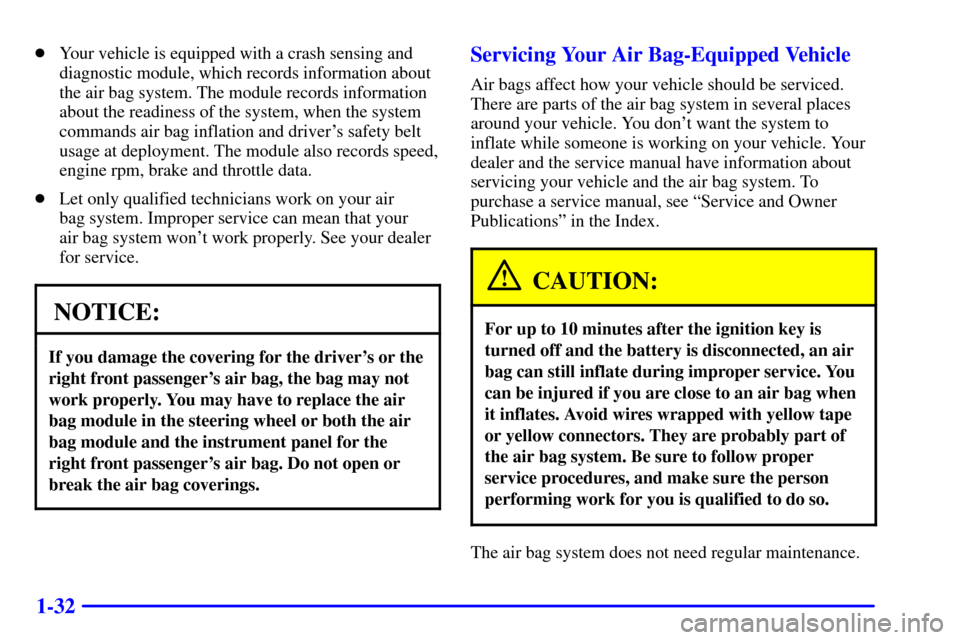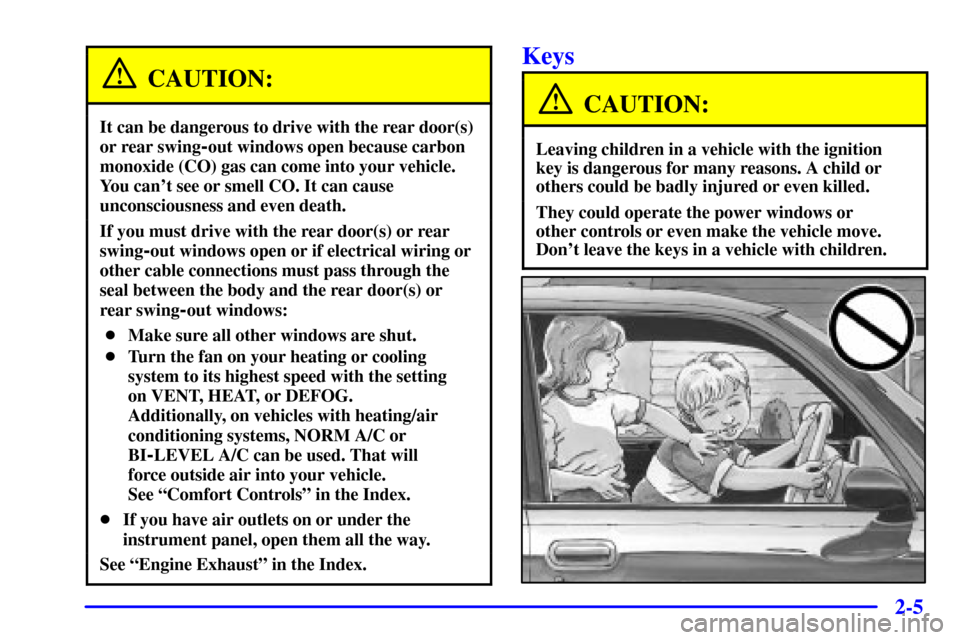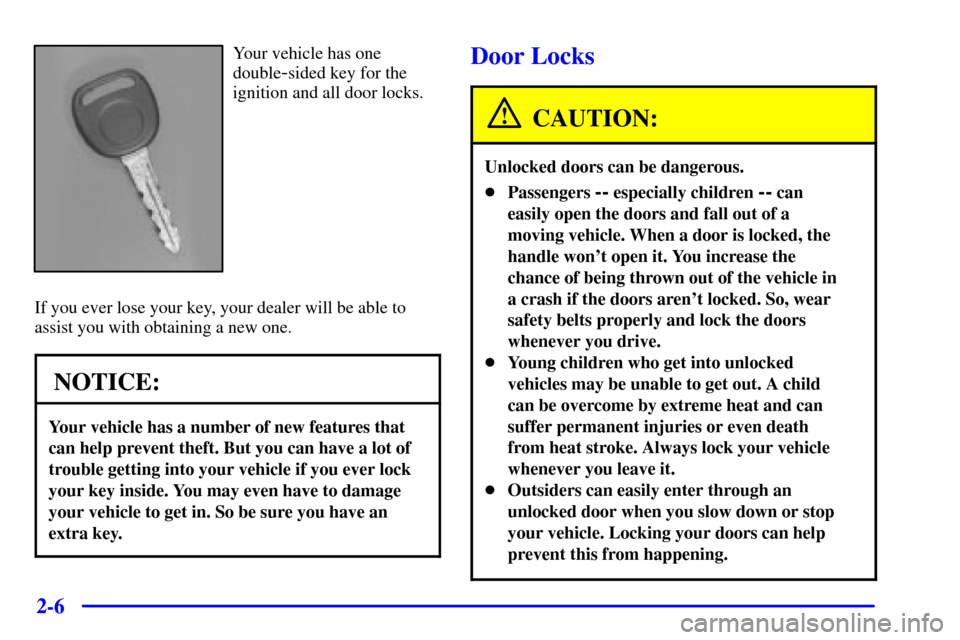Page 4 of 412
ii
Table of Contents
Windows
Keys and Door Locks
Keyless Entry System (If Equipped)
Automatic Transmission
Parking Brake
Tilt Wheel (Option)
Turn Signal/Multifunction LeverWindshield Wipers
Cruise Control (Option)
Exterior and Interior Lamps
Mirrors
Storage Compartments
Accessory Power Outlets
Instrument Panel, Warning Lights and Gages Seats and Seat Controls
Safety BeltsAir Bag System
Restraint Systems for Children
Section
1
Section
2
Seats and Restraint Systems
Features and Controls
Page 18 of 412
1-5 Rear Seats
Getting Into the Rear Seats
To make it easier for passengers to get into the rear
seats, use the fastener spot on the headliner and safety
belt sleeve. These will keep the safety belts out of the
way while people get into the rear seats.
Removing the Rear Seat
1. Disconnect the quick release latch plates for the lap
shoulder belts on the bench seat to be removed.
To do this, press the tip of a key into the release hole
of the safety belt buckle while pulling up on the
safety belt.
Page 38 of 412
1-25
The best way to protect the fetus is to protect the
mother. When a safety belt is worn properly, it's more
likely that the fetus won't be hurt in a crash. For
pregnant women, as for anyone, the key to making
safety belts effective is wearing them properly.
Right Front Passenger Position
To learn how to wear the right front passenger's
safety belt properly, see ªDriver Positionº earlier
in this section.
The right front passenger's safety belt works the same
way as the driver's safety belt
-- except for one thing.
If you ever pull the shoulder portion of the belt out all
the way, you will engage the child restraint locking
feature. If this happens, just let the belt go back all the
way and start again.
Air Bag System
This part explains the air bag system.
Page 45 of 412

1-32
�Your vehicle is equipped with a crash sensing and
diagnostic module, which records information about
the air bag system. The module records information
about the readiness of the system, when the system
commands air bag inflation and driver's safety belt
usage at deployment. The module also records speed,
engine rpm, brake and throttle data.
�Let only qualified technicians work on your air
bag system. Improper service can mean that your
air bag system won't work properly. See your dealer
for service.
NOTICE:
If you damage the covering for the driver's or the
right front passenger's air bag, the bag may not
work properly. You may have to replace the air
bag module in the steering wheel or both the air
bag module and the instrument panel for the
right front passenger's air bag. Do not open or
break the air bag coverings.
Servicing Your Air Bag-Equipped Vehicle
Air bags affect how your vehicle should be serviced.
There are parts of the air bag system in several places
around your vehicle. You don't want the system to
inflate while someone is working on your vehicle. Your
dealer and the service manual have information about
servicing your vehicle and the air bag system. To
purchase a service manual, see ªService and Owner
Publicationsº in the Index.
CAUTION:
For up to 10 minutes after the ignition key is
turned off and the battery is disconnected, an air
bag can still inflate during improper service. You
can be injured if you are close to an air bag when
it inflates. Avoid wires wrapped with yellow tape
or yellow connectors. They are probably part of
the air bag system. Be sure to follow proper
service procedures, and make sure the person
performing work for you is qualified to do so.
The air bag system does not need regular maintenance.
Page 78 of 412

2-
2-1
Section 2 Features and Controls
Here you can learn about the many standard and optional features on your vehicle, and information on starting,
shifting and braking. Also explained are the instrument panel and the warning systems that tell you if everything
is working properly
-- and what to do if you have a problem.
2
-2 Windows
2
-5 Keys
2
-6 Door Locks
2
-9 Keyless Entry System (If Equipped)
2
-16 Rear Doors
2
-17 Theft
2
-18 Passlock�
2-19 New Vehicle ªBreak-Inº
2
-19 Ignition Positions
2
-20 Starting Your Gasoline Engine
2
-23 Engine Coolant Heater (If Equipped)
2
-24 Automatic Transmission Operation
2
-27 Parking Brake
2
-28 Shifting Into PARK (P)
2
-31 Shifting Out of PARK (P)
2
-31 Parking Over Things That Burn2
-32 Engine Exhaust
2
-32 Running Your Engine While You're Parked
2
-33 Locking Rear Axle (If Equipped)
2
-33 Horn
2
-34 Tilt Wheel (Option)
2
-34 Turn Signal/Multifunction Lever
2
-40 Exterior Lamps
2
-42 Interior Lamps
2
-44 Mirrors
2
-47 Storage Compartments
2
-47 Cigarette Lighter/Ashtray
2
-48 Sun Visors
2
-50 The Instrument Panel - Your
Information System
2
-52 Instrument Panel Cluster
2
-54 Warning Lights, Gages and Indicators
Page 82 of 412

2-5
CAUTION:
It can be dangerous to drive with the rear door(s)
or rear swing
-out windows open because carbon
monoxide (CO) gas can come into your vehicle.
You can't see or smell CO. It can cause
unconsciousness and even death.
If you must drive with the rear door(s) or rear
swing
-out windows open or if electrical wiring or
other cable connections must pass through the
seal between the body and the rear door(s) or
rear swing
-out windows:
�Make sure all other windows are shut.
�Turn the fan on your heating or cooling
system to its highest speed with the setting
on VENT, HEAT, or DEFOG.
Additionally, on vehicles with heating/air
conditioning systems, NORM A/C or
BI
-LEVEL A/C can be used. That will
force outside air into your vehicle.
See ªComfort Controlsº in the Index.
�If you have air outlets on or under the
instrument panel, open them all the way.
See ªEngine Exhaustº in the Index.
Keys
CAUTION:
Leaving children in a vehicle with the ignition
key is dangerous for many reasons. A child or
others could be badly injured or even killed.
They could operate the power windows or
other controls or even make the vehicle move.
Don't leave the keys in a vehicle with children.
Page 83 of 412

2-6
Your vehicle has one
double
-sided key for the
ignition and all door locks.
If you ever lose your key, your dealer will be able to
assist you with obtaining a new one.
NOTICE:
Your vehicle has a number of new features that
can help prevent theft. But you can have a lot of
trouble getting into your vehicle if you ever lock
your key inside. You may even have to damage
your vehicle to get in. So be sure you have an
extra key.
Door Locks
CAUTION:
Unlocked doors can be dangerous.
�Passengers -- especially children -- can
easily open the doors and fall out of a
moving vehicle. When a door is locked, the
handle won't open it. You increase the
chance of being thrown out of the vehicle in
a crash if the doors aren't locked. So, wear
safety belts properly and lock the doors
whenever you drive.
�Young children who get into unlocked
vehicles may be unable to get out. A child
can be overcome by extreme heat and can
suffer permanent injuries or even death
from heat stroke. Always lock your vehicle
whenever you leave it.
�Outsiders can easily enter through an
unlocked door when you slow down or stop
your vehicle. Locking your doors can help
prevent this from happening.
Page 84 of 412
2-7
There are several ways to lock and unlock your vehicle.
If your vehicle is equipped with keyless entry, see
ªKeyless Entry Systemº later in this section for
more information.
From the outside, use your key.
To lock the door from the
inside, slide the manual
lever on your door down.
To unlock the door, slide the
manual lever up.
Power Door Locks (Option)
Press the bottom side of the
power door lock switch to
lock all the doors at once.
Press the top side of the
power door lock switch to
unlock all the doors at once.
When a door is locked, the inside door handle will
not work.